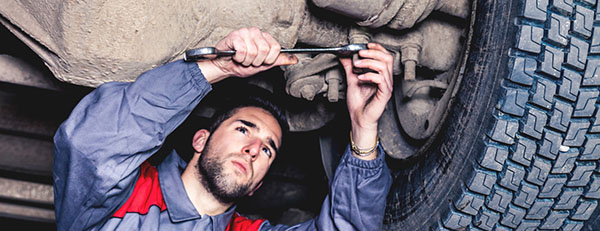Top 10 ways your clients can keep garage premiums low
Commercial producers, provide your insureds these 10 ways to keep garage premiums low, whether they own a garage, auto repair or service shop, muffler, stereo or tire store, when using our Automotive Aftermarket Express Package. These top 10 tips can help prevent injury or loss to help clients maintain low rates.
1. General workplace safety: The fewer their injury incidents, the lower their premiums will be. Have in place a safety manual (Arrowhead can provide a sample) and hold regular safety meetings. Preach and practice safety. In order to keep garage premiums low, remind your shop owners to:
Prevent slip & fall hazards
- Repair any cracks, holes and uneven spots at flooring joints. Keeping floors clean and dry is crucial for safety.
- Ensure stairs have proper handrails and slip pads.
- Train their team to never leave spills unattended, and keep oil-absorbing materials on hand.
- Remind employees to keep aisles, hallways and customer areas free of obstructions.
Electrical safety
- Teach and reinforce basic safety tips, such as never leave “on” tools unattended, ensure tools are turned off before plugging them in, and never use electric tools or equipment with wet hands or while standing in water.
- Inspect for frayed cords and overloaded power strips or circuits.
Material handling & safety
- Provide necessary material handling equipment such as transmission jacks, engine hoists, floor jacks or car pushers, and maintain the equipment.
- Teach safe lifting techniques to employees.
- Ensure tools and equipment are in close proximity to their techs.
2. Handling flammable materials: Use and store flammables safely; use extra caution when working on vehicle fuel tanks.
Working with combustible liquids
- Ensure approved containers are used for storage, and lids are closed while not in use.
- Only safety cans should be used for the dispensing of flammable or combustible liquids.
- Grounding and bonding should be used prior to dispensing or transferring flammable liquids.
Servicing fuel tanks
- Restrict this work to techs who’ve been sufficiently trained on safety issues.
- Ensure fuel is always drained first, preferably outside of the building.
- Provide approved pumps for the process; make sure no smoking or welding is allowed in the area.
3. Welding & cutting: Ensure proper fire safety precautions are taken in welding areas, to help keep garage premiums low.
- Never cut or weld near gasoline tanks or flammable/combustible materials.
- Use a fire watch during operations and keep a fire extinguisher handy.
- Inspect hoses daily.
- Store cylinders on a welding cart or secured to a wall.
4. Fire safety systems:
Sprinkler systems
- Inspect, test and maintain regularly.
- Ensure control valves are locked in the Open position with a robust chain and lock, or electronically monitored by a central station alarm system.
Fire extinguishers
- Note the various types of extinguishers, and place them in various areas according to the type of fire they’re best suited for.
- Provide at least one extinguisher for every 3,000 square feet.
- Travel distance from any point to an extinguisher should not surpass 75 feet.
5. Office/computer safety:
- To minimize slip and fall injuries, keep aisles clear of obstructions, keep the area well-lit.
- Maintain machines and equipment.
- Don’t stretch electrical cords across walkways.
- Lock computers when not in use.
6. Premises and vehicle security: Make it extremely difficult for anyone to break in and steal or vandalize, with lot protection, key control, inventory control building and vehicle security and intrusion alarms.
Facility security
- Install perimeter fencing; ensure all gates are reinforced and locked with heavy padlocks so that all traffic enters/exits from one point.
- Consider installing an intrusion alarm system and/or a contract security service.
Vehicle security
- Park vehicles closely together, bumper-to-bumper.
- Remove keys and lock them in a safe.
- If your client provides a “night owl” key drop box, ensure that keys/envelopes cannot be fished out of the slot or pulled under the door.
- Post signs reminding customers that this business will not be held responsible for personal articles left inside their vehicles.
7. Driver and vehicle safety, to keep garage premiums low
- Start with careful driver selection (including drug screening, a background and MVR check), followed by ongoing driver training and monitoring.
- Ensure employees know what to do if an accident occurs while they’re behind the wheel.
- Keep any shop vehicles properly maintained.
8. Customers onsite:
- All work areas should be posted as “Employees Only” or “Safety Regulations Prevent Customers from Waiting in Our Service Area.”
- Customers shouldn’t drive their own vehicles into the shop; instead, employees should drive the vehicle into service areas.
- Safe customer/pedestrian walkways should be clearly marked to guide customers into the waiting area.
- Ensure flooring has a slip-resistant surface for increased traction.
9. Automotive lifts:
- Allow only trained techs to use the lift.
- Inspect each daily, prior to use, and complete all maintenance issues.
- Never raise the lift with someone on it; before lowering, ensure the area is free of equipment, tools or people.
10. Preventing wheel-offs:
- Hire the best techs available.
- Provide initial and refresher training on critical job functions.
- Techs should crosscheck each other’s completed work. Managers or supervisors should spot-check all completed work, especially on safety-sensitive equipment such as tires, wheels, brakes and steering components.
- Whoever checks the work should sign the repair order acknowledging he did so.
These tips can help prevent loss at your client’s auto service facility, keeping claims low and positively impacting premium rates. Producer, you can download this list of ways to keep garage premiums low, and then print or email to your clients. We’ve saved a spot at the bottom for you to add your contact information prior to sending.

